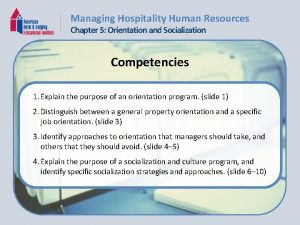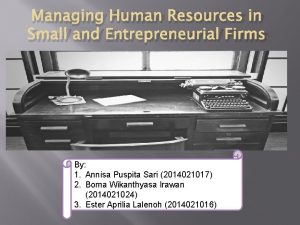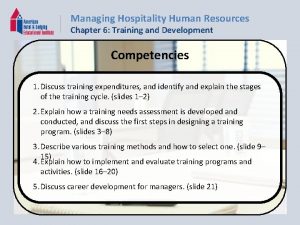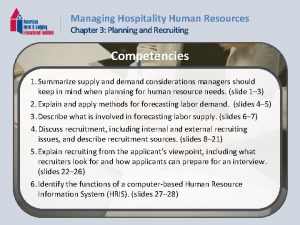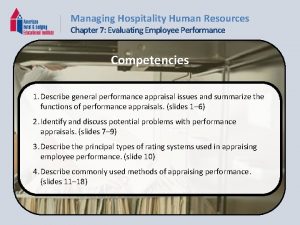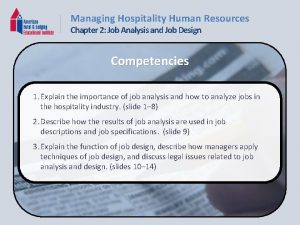Managing Hospitality Human Resources Chapter 5 Orientation and











- Slides: 11

Managing Hospitality Human Resources Chapter 5: Orientation and Socialization Competencies 1. Explain the purpose of an orientation program. (slide 1) 2. Distinguish between a general property orientation and a specific job orientation. (slide 3) 3. Identify approaches to orientation that managers should take, and others that they should avoid. (slide 4– 5) 4. Explain the purpose of a socialization and culture program, and identify specific socialization strategies and approaches. (slide 6– 10)

Managing Hospitality Human Resources Chapter 5: Orientation and Socialization Orientation Planning and Goals • Orientation is the process of introducing new employees to their work and the environment in which their work is completed. • New employees who receive orientation training tend to stay longer. • Orientation programs are designed to reduce the stress that employees feel when beginning a new job. • Orientation programs should include: • Information about job-related issues. • Information about cultural issues. • Information about specific job responsibilities and technical aspects of the job. Slide 1

Managing Hospitality Human Resources Chapter 5: Orientation and Socialization Orientation Programs • Orientation kits enable employees to review material discussed during the day. • Some properties divide orientation into two programs: general property orientation and specific job orientation. Slide 2

Managing Hospitality Human Resources Chapter 5: Orientation and Socialization General Property vs. Specific Job Orientation • General property orientation focuses on acquainting new employees with the organization and the property as a whole. • Specific job orientation focuses on topics directly related to job performance; it is designed to familiarize employees with their job responsibilities and work environment. Slide 3

Managing Hospitality Human Resources Chapter 5: Orientation and Socialization Approaches to Take • Welcome the new employee. • Help the employee develop positive impressions about the employer. • Confirm the employee’s decision to take the job. • Put the new employee at ease. Slide 4

Managing Hospitality Human Resources Chapter 5: Orientation and Socialization Approaches to Avoid • Putting too much emphasis on paperwork. • Assigning new employees easy jobs to ease them into the position. • Giving employees vague or incomplete information before tossing them into the job. • Giving employees too much information. • Providing unrealistic job previews. • Turning orientation over to a new employee. Slide 5

Managing Hospitality Human Resources Chapter 5: Orientation and Socialization Orientation Follow-Up • Orientation should have an end point, which should be followed by a period of close employee supervision. • Some companies have developed mentoring programs to provide continual close contact with experienced employees for the new employee’s first few months. • Managers may want to give a short test to determine whether new employees are adequately oriented to their new surroundings. Slide 6

Managing Hospitality Human Resources Chapter 5: Orientation and Socialization and Culture • New employees must under go socialization, i. e. , learn the values, norms, and behaviors of the organization’s social culture. • Research indicates that new employees who are effectively socialized to the organization are more productive more quickly than those who are not. • The effects of socialization were first noted in a study of civilian and military prisoners during the Korean War, where researchers found that through intensive indoctrination, Americans could be “converted” very quickly to partially reflect the values of their Communist captors. • Proper orientation and socialization can help reduce turnover. Slide 7

Managing Hospitality Human Resources Chapter 5: Orientation and Socialization Planning Socialization and Culture Programs • The socialization process consists of the following stages: • Welcoming activities • Understanding the organizational history, values, and purpose • Implementation of a realistic orientation program that addresses the stress new employees feel • Immediate connection to a person in a similar role or to a mentor • It is critical in the socialization process to offer a realistic orientation program designed to reduce new employee stress. Slide 8

Managing Hospitality Human Resources Chapter 5: Orientation and Socialization Strategies • Formal vs. informal • Individual vs. collective • Sequential vs. non-sequential • Fixed vs. variable • Tournament vs. contest • Serial vs. disjunctive • Investiture vs. divestiture Slide 9

Managing Hospitality Human Resources Chapter 5: Orientation and Socialization Who Should Socialize Newcomers? • While in many cases the best managers/employees should socialize newcomers, some studies suggest that it may be better done by marginal employees because often the performance of marginal employees improves at the same time new employees are socialized. • Newcomers can also provide employees with positive views of the organization by comparing their new job to the past jobs, which can help refresh current employees’ perspectives on their own jobs. • Research indicates that newcomers socialized by teams are more likely to learn the ropes faster. Slide 10
 Managing hospitality human resources
Managing hospitality human resources Chapter 10 managing human resources
Chapter 10 managing human resources Managing human resources in small and entrepreneurial firms
Managing human resources in small and entrepreneurial firms Managing human resources in small and entrepreneurial firms
Managing human resources in small and entrepreneurial firms Managing human resources in small and entrepreneurial firms
Managing human resources in small and entrepreneurial firms Managing global human resources
Managing global human resources Managing human resources bohlander
Managing human resources bohlander Bohlander and snell
Bohlander and snell Managing global human resources
Managing global human resources Hospitality technology systems
Hospitality technology systems Ethnocentric orientation examples
Ethnocentric orientation examples Chapter 8 study guide human resources culture and diversity
Chapter 8 study guide human resources culture and diversity
